Last week I gave a description of 20 highly recommended brand new books that have arrived here in the Dallastown shop. These were mostly theological or spiritual books, overtly Christian, and very important. They are almost all books that will become well known (and you may have even heard of them here, first!) If you missed that random list of good Christian books, please go back and look through that previous BookNotes. And order a few — they are tremendous.
Here is a deeper dive into some other titles that have come in. Some of these you may have heard of, most are not on faith-based publishing houses (although a few are) and, a few may not be destined for the best-sellers list. But, again, even if a few are a bit off the beaten path, these are books we think you’d like to know about and we are very eager to recommend.
All are discounted at 20% off for our BookNotes friends. Please use the link to our secure order form at the end of the newsletter to order. We really appreciate your interest (even if some of these books may not be found in your typical Christian bookstore.) Enjoy.
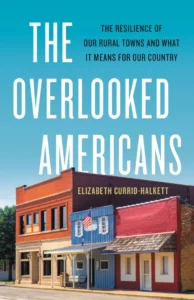 The Overlooked Americans: The Resilience of Our Rural Towns and What It Means for Our Country Elizabeth Currid-Halkett (Basic Books) $32.00 – OUR SALE PRICE = $25.60
The Overlooked Americans: The Resilience of Our Rural Towns and What It Means for Our Country Elizabeth Currid-Halkett (Basic Books) $32.00 – OUR SALE PRICE = $25.60
We have a number of books about what might be called the sociology of place, books looking at new urbanism as well as small town and rural life titles. (In our church section, we also have books about rural churches and small town ministry.) This is considered to be a much-needed reassessment of small town life, done by a major scholar — she was a recipient of a Guggenheim Fellowship and holds a chair of Modern Culture at the Library of Congress. As an expert on regional planning, she sees the big picture, but knows that the devil is in the details, as they say.
Richard Florida (a name you should know) says that the book reveals “life in rural America to be complex and varied — and in many cases better off than conventional wisdom would have us believe.” Happily, she will make a case that urban, suburban, and rural Americans may have more in common than we think. Currid-Halkett combines both quantitative research and fine storytelling to offer a new understanding of what’s going on — the grit and the grace — among rural and small town Americans. This just came and I’m eager to study it.
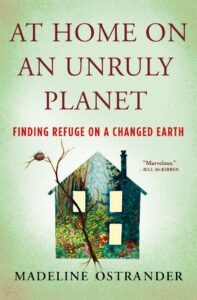 At Home on An Unruly Planet: Finding Refuge on a Changed Earth Madeline Ostrander (Holt) $28.99 – OUR SALE PRICE = $23.19
At Home on An Unruly Planet: Finding Refuge on a Changed Earth Madeline Ostrander (Holt) $28.99 – OUR SALE PRICE = $23.19
I think this may be one of the best written and most compelling books — a page-turner, for me — that I have read in quite a while. In a work that Bill McKibben calls “marvelous” and more than one reviewer calls “compassionate” this investigative journalist has studied (for years) four different places that have experienced a certain sort of very bad impact due to climate change. As she traces the stories of a few key characters in these regions, we learn their backstory, their crisis, their bravery, and their hope for some sort of sustainable living in these changing landscapes.
There is, to begin this whole study, a moving and informed rumination on the meaning of and the importance of a sense of place and a perception of home.
Ooooh, I kept thinking of the masterpiece by Brian Walsh & Steven Bouma-Prediger, Beyond Homelessness: Christian Faith in a Culture of Displacement which is coming out in September in a newly updated and considerably expanded edition. (Eerdmans; $39.99 – OUR 20% SALE PRICE = $31.99.) YOU CAN PRE-ORDER IT FROM US NOW.
Indeed, the human need for homemaking as a place for the creation and discovery of durable meaning, is explored beautifully. As Bill McKibben puts it “Home may be the most pungent word in the language — and it’s no longer something any of us can take for granted.” Madeline Ostrander makes this clear and oddly exciting.
The four locations and contexts about which Ostrander writes in luminous detail include the wooded rural areas north of Seattle in the Pacific Northwest (and the crisis of forest fires, seen mostly through the eyes of a forest biologist and smoke jumping firefighter), the East coast of Florida and extraordinary drama of life-changing hurricanes (seen, fascinatingly, through the eyes of a woman who works in historic preservation in the oldest European-settled town in America, St. Augustine), a northern California urban landscape plagued by fossil-fuel disasters, including a toxic explosion (seen mostly through the eyes of a black, urban farmer) and, finally, the sea-rise in Alaska forcing the a village of Yupik people to start a decades long effort of moving to a new location as their land warms and erodes beneath them.
As the At Home on An Unruly Planet book cover says, rightly, “Ostrander pairs deep reported stories of hard-won optimism with lyrical essays on the strengths we need in an era of crisis.” Some may appreciate the essays in between the reporting of these four unfolding dramas, although those major four stories had me up late at night, sweating it out.
The author is the former senior editor of YES! magazine, holds a master’s degree in environmental science. She’s a very good writer, vividly doing the best kind of narrative nonfiction, taking us to these four locations to learn so much about the actual influence of a changing climate. What a book!
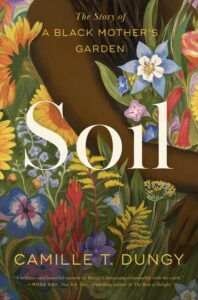 Soil: The Story of a Black Mother’s Garden Camille T. Dungy (Simon & Schuster) $28.99 – OUR SALE PRICE = $23.19
Soil: The Story of a Black Mother’s Garden Camille T. Dungy (Simon & Schuster) $28.99 – OUR SALE PRICE = $23.19
I heard just a tiny bit about this book and knew it would be one we’d love to feature. Reading an advance review or two make me realize this “brilliant and beautiful memoir” was one both Beth and I would want to read. A few years ago we highlighted the world of Aimee Nezhukumatathil (World of Wonders: In Praise of Fireflies, Whale Sharks, and Other Astonishments) and when I realized she had vividly endorsed it, I was all in. It arrived just last week and it is high on my stack of summer reads.
The book chronicals several years of her learning to develop an extesnive garden on her propertly. When she first got the idea, the Homeowner’s Association had a rule against such stuff. They were going for homogeneity, not colorful diversity; Dungy, one of the few black homeowners in the association comes to learn that plant biodiversity is a good thing, and I suppose the metaphor can be extended, eh? One sometimes has to work at these things.
Ross Gay, himself quite a writer and author of the much-appreciated The Book of Delights, suggests, in poetic fashion, at what is most deeply going on in this passionate story of gardening: “Soil demands we witness what erodes or frays or severs the stabilizing roots between us. Let us put our hands in and try to listen.”
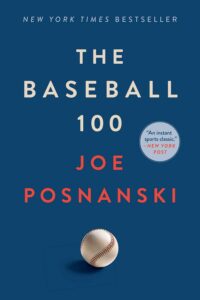 The Baseball 100 Joe Posnanski (Avid Readers Press) $25.00 – OUR SALE PRICE = $20.00
The Baseball 100 Joe Posnanski (Avid Readers Press) $25.00 – OUR SALE PRICE = $20.00
This is not a brand new book but it is quite new in paperback. What a fun resource this is, which will afford baseball fans hours of fine, sports-themed reading. (And I mean hours — the speeded up game times this year won’t apply here; if you include the index this is 870 pages long.) As it says on the back, The Baseball 100 is “longer than Moby-Dick and nearly as ambitious.” It is a one-of-a-kind work by this beloved and award-winning sportswriter. If you follow sports journalism at all, you know the name of Joe Posnanski.
It is, quite simply, Posnanski’s “fascinating deep dive” into the careers of those he considers baseball’s 100 greatest players. Counting down from 100 to the obvious number 1.
Here are some of the fun blurbs on the back:
I love baseball, I know baseball, and this book is baseball. It’s the whole story of baseball told through the 100 greatest players of all time . . . But what really makes me say, ‘Give this to the baseball people in your life,’ is that it’s a book that, when you read it, you fall in love with the game all over again. . . . Every sport needs great players, but it also needs great writers, and Joe Posnanski has done something great for the game of baseball with this book. — Tony Dokoupil, CBS This Morning
Stellar . . . Always fun . . . A book for the moment but also for the bookshelf of the future, an old friend that will bring back old times and old arguments again and again…The rankings were all made by Mr. Posnanski, who is contemporary sports writing’s biggest star. He writes with grace and wit, combining an old-time sense of style with the mountains of numbers and factoids and observations that can be found on the internet. — Leigh Montville, The Wall Street Journal
Major League Baseball fans, you just won the lottery. . . . Posnanski presents 880 pages of sheer baseball bliss . . . It’s a true masterwork, and his writing is so good that it’s likely to engross even those who know nothing about the sport. — BookPage
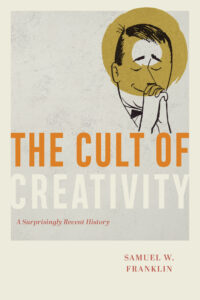 The Cult of Creativity: A Surprisingly Recent History Samuel W. Franklin (University of Chicago Press) $26.00 – OUR SALE PRICE = $20.80
The Cult of Creativity: A Surprisingly Recent History Samuel W. Franklin (University of Chicago Press) $26.00 – OUR SALE PRICE = $20.80
I sometimes am reluctant to recommend academic press titles for fear they will seem too arcane or scholarly. This book is neither and it is fantastic. Granted, as with other social histories, there is much detail, but it is vivid and the illustrative stories and examples are always set within the broader context of the author’s thesis and what is going on. I can’t tell you how fascinating this is.
Here’s the gist: today it is nearly ubiquitous how often we talk about creativity — there is even a sub-grouping of people whom we call “creatives.” We find in The Cult of Creativity that this is a very recent notion (and even a relatively recent use of the word.) There have always been artists and ingenuity and inventiveness was seen as traits of those gifted with artistic talent or in leadership, but rarely in history has the notion of creativity been applied. And starting after World War II — seemingly almost overnight — it became a topic studied by think tanks and research institutes, there were symposia and confabs and much money was offered by foundations to psychologists to discern what makes for a “creative” person. How this came out of the blue is a major concern of the first chapter or two and they, alone, are worth the price of the book, placing this exciting new cultural invention in the context of resistance to the drab and bureaucratic technocratic culture.
Alas, this new fashion to document who was creative (the amount of money and effort put into this is phenomenal) was not, however, mostly aimed at artists or romantic hippies who would resist mass society (although it foreshadows books like The Lonely Crowd, One Dimensional Man and Where the Wasteland Ends, and near the end cites the worries of Jacques Ellul, which I was glad to see.) In many ways — Franklin shows this impeccably — this new-found passion for progress (by connecting it to creative personality types was part of the Cold War battle against communism and our fears of losing “the space race” as we used to call it. In a way, the cause of and the cult-like status of “the creatives” was embraced by the left and the right, although the original impulse was to deepen the success of our efforts in science, technology, industry, and the economy, with mad-men advertisers in the vanguard of that aspect.
Thought leaders of that era were working on this question of enhancing creativity, again, mostly funded by Rockefeller and Carnegie and executed by psychologists for the sake of the Pentagon, IBM, et al. From Arnold Toynbee to John Gardner to O. Hobart Mowrer to William Whyte to the young Peter Drucker, research and social science was garnered, thought-pieces were floated, articles and eventually TV shows about it all were created, as the ideas trickled down to today’s common parlance, revealing our common assumptions that this is, in fact, a thing.
Who knew? The Cult of Creativity and its “surprisingly recent” history should be pondered by today’s thought leaders, especially within the church, where the assumptions about innovation and creativity sometimes run wild.
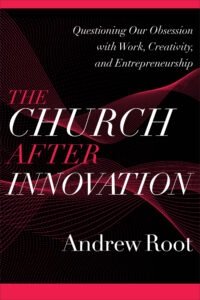 Franklin’s amazing historical study reminded me of a book I’ve mentioned before, which also weaves together history, cultural studies, and astute social observation — The Church After Innovation: Questioning Our Obsession with Work, Creativity, and Entrepreneurship by Andrew Root (Baker Academic; $27.99 / OUR SALE PRICE = $22.39.) Not long ago I did a whimsical presentation about the importance of Root’s book at a gathering of church leaders working on their creativity and innovation. It didn’t sell well, shall we say, despite my clever invitation to consider it alongside their valuable theme. Maybe somebody here will pick it up.
Franklin’s amazing historical study reminded me of a book I’ve mentioned before, which also weaves together history, cultural studies, and astute social observation — The Church After Innovation: Questioning Our Obsession with Work, Creativity, and Entrepreneurship by Andrew Root (Baker Academic; $27.99 / OUR SALE PRICE = $22.39.) Not long ago I did a whimsical presentation about the importance of Root’s book at a gathering of church leaders working on their creativity and innovation. It didn’t sell well, shall we say, despite my clever invitation to consider it alongside their valuable theme. Maybe somebody here will pick it up.
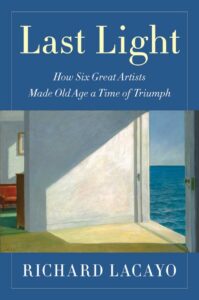 Last Light: How Six Great Artists Made Old Age a Time of Triumph Richard Lacy (Simon & Schuster) $35.00 – OUR SALE PRICE = $28.00
Last Light: How Six Great Artists Made Old Age a Time of Triumph Richard Lacy (Simon & Schuster) $35.00 – OUR SALE PRICE = $28.00
Okay, this isn’t brand new (maybe one or two of the only ones on the list that are not.) But it is pretty new to us and it seems new enough to highlight it here. My, my, I have fallen in love with this, perusing it at leisure, dipping in here and there. I really do want to read this carefully and I suspect some of our BookNote readers will, too.
The subtitle tells the whole story; holding the book and its heft in the hand will remind you it is a substantive work, well made, with full color reproductions throughout. It is just what it suggests — it asks how aging influenced the works of six major visual artists. The Director of the Whitney Museum of America Art says, “Lacy’s probing portraits compel us to consider the vicissitudes of an artist’s entire creative life, not just ‘the brand’ of singular works, styles or periods.”
This chronicle of “the varieties of artistic old age” is amazing and, I suggest, will finally be an important read — perhaps transformational for you — whether you are interested in these artists or not, and whether you are yourself in old age or not.
Lacayo investigates Titian, Hopper, Matisse, Nevelson, Monet, and Goya.
How do some great artists stay creative — even innovative — as they get older? Among other things, some become more daring, as Richard Lacy shows in this fascinating book. It’s a secret that’s useful in all walks of life. — Walter Issacson, author of Leonardo da Vinci
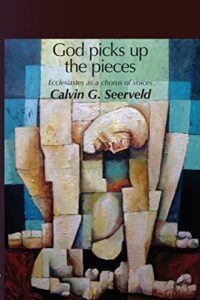 God Picks Up the Pieces: Ecclesiastes as a Chorus of Voices Calvin G. Seerveld (Dordt College Press) $14.99 – OUR SALE PRICE = $11.99
God Picks Up the Pieces: Ecclesiastes as a Chorus of Voices Calvin G. Seerveld (Dordt College Press) $14.99 – OUR SALE PRICE = $11.99
I suppose it is proper, maybe even sweet, to list this one after the mention of the magisterial Last Light, above, even though it is a small paperback. Seerveld is himself aging, and yet remarkably prolific. He is the preeminent Christian art historian of our time, a writer widely known for his colorful arguments about aesthetics; Seerveld is also a considerably trained theologian (his weeks of late night studies in Europe and his brief meeting with Barth is nearly legendary) and an expert Bible translator. He has written numerous books of Scriptural reflection, including How to Read the Bible to Hear God Speak, Voicing God’s Psalms, How to Read the Biblical Book of Proverbs, a small work offered as a study companion to Song of Songs entitled Never Try to Arouse Erotic Love Until . . . (not to mention his major play, The Greatest Song – In Critique of Solomon written as a perfomance piece of Song of Songs, which is extraordinary) and, recently, a beautiful collection of sermons he preached in Toronto on the book of Revelation, Bewildering God’s Dumbfounding Doings. He is acclaimed well by the likes of the brilliant and prominent Old Testament scholar Craig Bartholomew, and should be read for his quirky, smart, often tender Biblical research.
Which brings us to this: God Picks Up the Pieces, on Qoheleth and the book of Ecclesiastes. It is not a commentary, as such, but a creative re-working of the book “as a chorus of voices.” That is, he believes there should be multiple readers (not unlike his acclaimed Song of Songs project) to get the storied flow of the narratives and this translation captures the performative natures. As Bartholomew puts it in a long, eloquent endorsement on the back cover, “The way they are written performs their message.” Long story short: God Picks Up the Pieces is written out like a paraphrased/re-translated script so that the drama of Ecclesiastes can be read out loud, together. As such, “In the process,” as Bartholomew notes, “Seerveld makes a major contribution to our hearing and thus giving this masterpiece.”
Besides the re-rendering of the ancient book, there is a chapter offering some notes for producing performances and another little section called “post-performance comments.” There is a seriously footnoted chapter which shows his exegetical work, illustrating the logic and intuition of his linguistic and rhetorical choices, there is a meditation on artworks which reinforce insights of Ecclesiastes and a chapter of some personal comments. The bibliography will be useful for scholars and his appendix “on the hermeneutics of holy Scripture wisdom literature” is deliciously studious, not cryptic, but detailed.
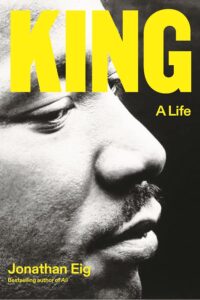 King: A Life Jonathan Eig (FSG) $35.00 – OUR SALE PRICE = $28.00
King: A Life Jonathan Eig (FSG) $35.00 – OUR SALE PRICE = $28.00
I have read most of Dr. King’s books and many studies of his work and movement, from his prayer life to his academic influences, his preaching to his organizing. Many of the great biographies about him have been nearly transformational for me. Although books about him keep coming out, no one has done a major comprehensive biography in decades. Decades!
There is no doubt that this is now the definitive volume, a 600 page, landmark magnum-opus, replacing David Garrow’s Pulitzer Prize-winning Bearing the Cross, for that honor. Garrow, in a ringing endorsement on the back, nearly says as much, indicating that this is the best original and comprehensive work on King in more than thirty-five years. Drawing on new documentary resources, “the result is a great leap forward in our biographical understanding.”
The new documentary resources mentioned include recently declassified, newly released, FBI data, and Big — a respected biographer — has, in the words of Ken Burns, “pulled off a kind of a miracle.” Burns exclaims:
Here is the leader, the preacher, the orator, the husband, the father, the martyr, the human being — not with melodramatic halo in place, but in all his heroic, tragic glory. Hallelujah!
The book is getting a lot of buzz (there was a good interview and story about the book alongside an excellent review in The New York Times a week or two ago.) Here’s a good podcast interview with author Jonathan Eig. Eig has written very popular biographies of various characters from Mohammand Ali to Lou Gehrig to Al Capone; he is a great researcher and a good writer. We are honored to recommend it.
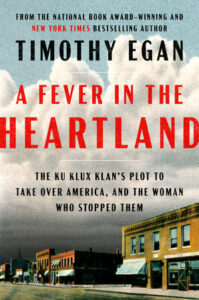 A Fever in the Heartland: The Ku Klux Klan’s Plot to Take Over America, and the Woman Who Stopped Them Timothy Egan (Viking) $30.00 – OUR SALE PRICE = $24.00
A Fever in the Heartland: The Ku Klux Klan’s Plot to Take Over America, and the Woman Who Stopped Them Timothy Egan (Viking) $30.00 – OUR SALE PRICE = $24.00
When a National Book Award-winning and bestselling author does an important new book, you know it is a great season to be in the book business. I don’t know how many of our customers will buy this, but we are proud to stock it, happy to suggest it and a new classic in narrative nonfiction. I hope you know Egan as a journalist and historical documentarian, having written that amazing bestseller on the dust bowl (The Worst Hard Time) and a book on a seminal moment in American conservation The Big Burn: Teddy Roosevelt and the Fire That Saved America.
This, too, is a storied — but mostly untold — page-turning adventure, set in the “jazz age” of the Roaring Twenties. It was the height of that uniquely American hate group, the KKK, working less in the old Confederacy but more in the great Midwest. They hated Blacks, Jews, Catholics, and immigrants (and often, we learn, bought off pastors to preach their gospel of bondage.) The first part of this fever story tells of the rise of D.C. Stephenson and his KKK organizing, mostly in the state of Indiana. Ahh, but this propulsive story takes a turn as a seemingly powerless woman named Madge Oberholtzer reveals Stephenson’s secret cruelties and eventually, as the dust jacket promises, “brought the Klan to its knees.” This historical thriller is obviously important and sadly still relevant. We are glad for Egan’s good work; he has been called brilliant as a researcher and lucid as a writer. What a read.
Powerful . . . As a narrative, A Fever in the Heartland is gripping; as a rumination on the moral obscenity of white supremacy — whatever guises it wears — the book is damning. —The New York Times Book Review
A master class in the tools of narrative nonfiction: high stakes, ample suspense and sweeping historical phenomena made vivid through the dramatic actions of individual villains and heroes. —The Washington Post
Egan has done it again, mastering another complicated American story with authority and surprising detail. The Klan here are not the nightriders of the late 19th century, but a retooled special interest group and unusually potent political power. The influence they wielded over states and policy should put a chill in every American. Bravo. — Ken Burns
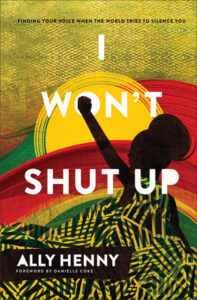 I Won’t Shut Up: Finding Your Voice When the World Tries to Silence You Ally Henny (Baker) $24.99 – OUR SALE PRICE = $19.99
I Won’t Shut Up: Finding Your Voice When the World Tries to Silence You Ally Henny (Baker) $24.99 – OUR SALE PRICE = $19.99
I hope you have at least heard of Ally Henny, a writer, speaker and activist, a pastor and leader of The Witness: A Black Christian Collective, which is an important organization working to equip and empower black Christians in working against racism and liberation from trauma. She has an MDiv from Fuller Seminary (with an emphasis in race, cultural identity, and reconciliation.) She has a good, good following and now more of us can listen in. Hooray.
In this new era when being “woke” is hated and despised by some, and thinking critically about race and racism is suspect in some circles, folks of all races need not only a vision of kind and gracious gospel-centered civility (obviously) but, also, the strength and fortitude to speak up. The blunt title — I Won’t Shut Up — captures something of the necessary tone, especially for people of color.
Perhaps like Kathy Khang’s Raise Your Voice: Why We Stay Silent and How to Speak Up, an often used IVP paperback, Ally Henny offers lots of stories, making this almost a memoir, all the while exposing the forces that tend to embarrass or silence black women, especially.
This book is a love letter to every Black woman and girl who has been told that we are too loud, too angry, too intimidating, too outspoken, too nonconformist, too Black, too feminist, too much. — Dr. Chanequa Walker-Barnes, clinical psychologist, public theologian, and author of I Bring the Voices of My People and Too Heavy a Yoke
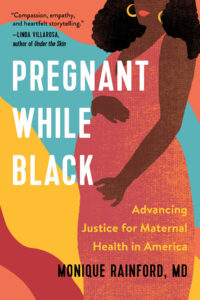 Pregnant While Black: Advancing Justice for Maternal Health in America Monique Rainford (Broadleaf) $26.99 – OUR SALE PRICE = $21.59
Pregnant While Black: Advancing Justice for Maternal Health in America Monique Rainford (Broadleaf) $26.99 – OUR SALE PRICE = $21.59
This is nothing short of a groundbreaking and comprehensive exploration of adverse maternal-health outcomes for black women in America. That’s a bit terse, but there it is, the blunt truth. It should be widely known that there is a crisis in health care revolving quite specifically about mistreatment of people of color. (One of the most compelling books about that is one we reviewed and named as one of the best books of 2022, Under the Skin: The Hidden Toll of Racism on American Lives and on the Health of Our Nation by Linda Villarosa — it is now out in paperback, by the way.) One of the arenas where the injustices and perplexities of unjust health care shows itself is in the data about black women and their pregnancies and this book is a popular-level, passionate treatment. It is written by a well respected obstetrician and gynecologist (who studied at U. of Penn and Harvard Medical School) and now works at Yale Medicine.
Anyone seriously interested in race-based inequities in our society needs to know this stuff. Anyone interested in health care needs to know this stuff. Anyone interested in childbirth, midwifery, and the like really needs to know this. I would suggest that married couples of African descent should read this. Kudos to the Lutherans at Broadleaf for bringing such an important book to publication.
Pregnant While Black is the beautiful and profound expansive work on Black maternal health that we’ve all been waiting for. The book guides us through heartbreaking personal stories using data and evidence to help readers understand the full devastating impact of this very American crisis. Dr. Rainford invites us in to work toward a more equitable and just future for Black pregnant people. — Dr. Uché Blackstock, physician, thought leader on bias and racism in health care, and founder of Advancing Health Equity
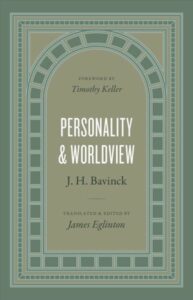 Personality & Worldview J. H Bavinck (Crossway) $22.99 – OUR SALE PRICE = $18.39
Personality & Worldview J. H Bavinck (Crossway) $22.99 – OUR SALE PRICE = $18.39
We have recommended a few other books by the Dutch Reformed missiologist (and nephew to the great neo-Calvinist Herman Bavinck) and we are delighted to share about this recent one as well. I’m told the translation (by James Eglinton, who wrote the definitive biography of Herman Bavinck, is excellent.) The strength of this fascinating study — originally written in 1928 — is how it navigates the relationship between what were then two fairly new topics of study in theological circles, personality and worldview. To this day, I wonder if any others have so deeply reflected on the intersection. It is asking questions about the deep formation of meaning and, by several accounts, anticipates Charles Taylor’s notion of a communal “social imaginary.” It is offering unique and potent contributions to the conversations around worldview, what is meant by that, and why — in recent years — some find it to be a less than helpful phrase.
Here’s another reason to want to know about this handsome 180 page volume. It has a forward by Timothy Keller (maybe one of the very last things he wrote?) It starts with these two sentences:
I could not be happier that Johan Herman Bavinck’s Personality and Worldview has been made accessible to the English-speaking world. It is an important work, perhaps even what we call a “game-changer.” — Timothy Keller, Hope in Times of Fear
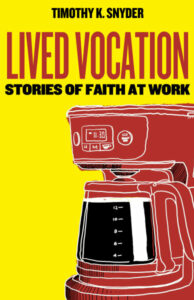 Lived Vocation: Stories of Faith at Work Timothy K. Snyder (Fortress Press) $21.99 – OUR SALE PRICE = $17.59
Lived Vocation: Stories of Faith at Work Timothy K. Snyder (Fortress Press) $21.99 – OUR SALE PRICE = $17.59
I like that Dr. David Jensen academic Dean and Professor of Austin Presbyterian Seminary, calls this author, Timothy Snyder, a “theological Studs Terkel.” It’s a great and appropriate phrase, but for those who may not be old enough to recall, Terkel — sort of a blue collar-type, cigar-chomping, Chicago union guy and award winning oral historian —achieved all kinds of acclaim when in the 1970s he did a massive and riveting book called Working which was mostly interviews with hundreds of people, many sharing their deep disgust of feeling alienated from their work, often doing dirty and dangerous jobs to little acclaim.
There was in that book the good, the bad, and the ugly, as we used to say, and Working set off a flurry of concern about regaining the dignity of work. This, naturally, set up both mainline denominational folks and socially-engaged evangelicals to speak about vocation and calling, the way work matters in God’s common grace to keep the world flourishing, and how the problems voiced by Terkel’s interviewees night be mitigated by Christian thinking and gospel influence. From Lutheran leaders like William Diehl to American Calvinists like RC Sproul to Dutch Kuyperians in Canada, distinctively Christian views of work were arising in the 1970s and these influences shaped our thinking about the nature of our own calling as booksellers and how we curated our own bookstore’s inventory (with sections for teachers, counselors, lawyers, scientists, engineers, businesspeople, nurses, journalists, and so on.) Lee Hardy took some of this in with us in Pittsburgh in the early 1980s and soon published his enduring book Fabric of Work: Inquirers into Calling, Career Choice, and the Design of Human Work and another Pittsburgh friend fro those years, Steve Garber, wrote, eventually Visions of Vocation.
Years later, we we delighted to learn that Tim Keller and Katherine Alsdorf, a congregant who was a corporate executive of some note, started the Redeemer Center for Faith and Work. That sort of center to equip workers in their careers areas has been duplicated all over the country (see, for instance, the stellar work of the Denver Institute on Faith and Work, just for one example) or consider the energetic evangelical efforts of Made to Flourish, founded by Tom Nelson (author of Work Matters: Connecting Sunday Worship to Monday Work.) Most groups draw on books like Keller & Alsdorf’s Every Good Endeavor: Connecting Your Work to God’s Work and a thorough, serious study by Amy Sherman, Kingdom Callings: Vocational Stewardship for the Common Good. A few even order my own edited collection, Serious Dreams: Bold Ideas for the Rest of Your Life which is a great gift for college graduates entering the work world.
Which brings us back to this new collection of inspiring stories of work and faith. I like that Snyder (who teaches at General Theological Seminary in NYC) admits to a lot of rethinking of his own sense of calling and vocation as he explores those who have a sense of vocation about their own seemingly secular work. If Terkel’s interviews gave voice to oppression and dissatisfaction, Snyder hears everyday people affirming a sense of God’s presence in their own lives and how theology is done by common folks in the seemingly mundane. That he interviewed as a Lutheran other Lutheran people is unique, but doesn’t change the urgency of this kind of book for all of us.
It is hoped (or so the back cover suggests) that these interviews and Snyder’s reflections in Lived Vocations “will help leaders empathize with the difficulties of integrating faith in everyday life today and will encourage them to tell stories of their own.” He’s an astute listener and good storyteller and in this sense is, indeed, a theological Studs Terkel, and it is special (although not extraordinary, these days) that he calls for a theology of improvisation, of incarnation, of thinking together about the meaning of God’s call.
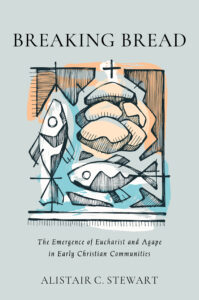 Breaking Bread: The Emergence of Eucharist and Agape in Early Christian Communities Alistair C. Stewart (Eerdmans) $49.99 – OUR SALE PRICE = $39.99
Breaking Bread: The Emergence of Eucharist and Agape in Early Christian Communities Alistair C. Stewart (Eerdmans) $49.99 – OUR SALE PRICE = $39.99
This is brand new and I cannot say much about it other than to note that the author is known as an extraordinary scholar, impeccable and honest, and an expert in early church studies. He is a working Anglican priest in the UK who does this historical theology. His book The Original Bishops on the development of offices and order of the church is widely discussed among those who study the first few hundred years of church history.
Most of us have heard of the agape feast which we are told was a common practice in the earliest communities of Christ-followers. How and when did eucharist, as such, develop? What is the difference between Eucharist and agape? How did each “meal rite” come to be? And, importantly, given that the practice and spirituality of these rituals developed and evolved, is it sensible to try to recreate early Christian practice in our contemporary congregations?
Here is what a few key scholars say about Breaking Bread.
Although in the past Alistair and I have usually found ourselves on opposite sides of debates about early Christian worship, his latest book evokes nothing but praise from me for its comprehensive and highly detailed approach to the subject. — Paul F. Bradshaw, University of Notre Dame
Alistair Stewart’s work is always rigorous as well as creative, and the deployment of his acute interpretive skills to the question of eucharistic origins in such a thorough way as this is very welcome. Even where we disagree, his probing analysis does not fail to shed new light, and this account will now be a necessary point of reference for the topic. — Andrew McGowan Yale Divinity School
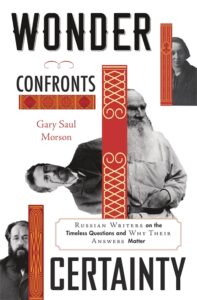 Wonder Confronts Certainty: Russian Writers on the Timeless Questions and Why Their Answers Matter Gary Saul Morton (Belknap / Harvard University Press) $37.95 – OUR SALE PRICE = $30.36
Wonder Confronts Certainty: Russian Writers on the Timeless Questions and Why Their Answers Matter Gary Saul Morton (Belknap / Harvard University Press) $37.95 – OUR SALE PRICE = $30.36
While this book is just under 500 pages, it feels heavier, and, for me, will be slow going. But, my, oh my, what an education — like taking an advanced study of Russian history and culture and Russian literature. The introduction alone is nearly 40 dense pages and I had to talk with Beth about some of it (and we both fled to google to look up the various Nicholas’s and Alexandria’s.) No country has valued literature as have the Russians, says Professor Morton, and no people group have loved to argue about the obscurities of the deepest things about the meaning of life than the quintessential Russian; he makes his point with a brief look at “The Grand Inquisitor” piece in Dostoevsky and a famous part of The Brothers Karamazov in which Ivan speaks with Alyosha about Russian boys in a “stinking tavern” talking about the eternal questions.
The history of injustice, the inequities and wars, the Russian genocide and the terrible invention of brutal Soviet communism puts the quest for big answers into extreme relief. At the heart of the second portion are three big chapters exploring what he describes as three types of thinkers, “The Wanderer: Pilgrim of Ideas”, “The Idealist: Incorrigible and Disappointed” and “The Revolutionist: Pure Violence.” Wonder Confronts Certainty covers so much and is such a magisterial force that it will become known as a classic, I am sure.
A compelling and necessary book. Drawing on a vast fund of knowledge of Russian history and literature and a fine understanding of Russian fiction, Morson joins together two large subjects: a riveting — and scary — account of the Russian cult of murder from nineteenth-century terrorism to its continuation in Soviet state terror, and its humanistic antidote in the great Russian novelists. — Robert Alter, author of The Hebrew Bible: A Translation with Commentary
An impeccable contribution to literary criticism, social philosophy, and philosophical anthropology. Against debilitating nihilism and secular and religious fundamentalism, it affirms dialogue, conversation, and the ‘polyphonic’ expression of rich and diverse personal points of view. Morson embodies the best insights of the Russian literary tradition he sets out to illuminate. — Daniel J. Mahoney, author of The Statesman as Thinker: Portraits of Greatness, Courage, and Moderation
A profound, passionate, and wholly original celebration of Russian realism as both literary school and way of life. Invoking bitter historical precedent, Morson shows us that reality itself —t he sensual, moral experience of living and loving actual humans — requires an able defender in the face of alluring theoretical abstractions, perfect futures, and idealized visions of humanity. And who better to defend the prosaic elements of lived experience than those writers whose unprecedented achievements depended on their ability to describe it so well? — Yuri Corrigan, author of Dostoevsky and the Riddle of the Self
TO PLACE AN ORDER
PLEASE READ, THEN SCROLL DOWN AND CLICK ON THE “ORDER HERE” LINK BELOW.
It is very helpful if you tell us how you prefer us to ship your orders.
The weight and destination of your package varies but you can use this as a quick, general guide:
There are generally two kinds of US Mail options, and, of course, UPS. If necessary, we can do overnight and other expedited methods, too. Just ask.
- United States Postal Service has the option called “Media Mail” which is cheapest but can be slow. For one typical book, usually, it’s about $3.85; 2 lbs would be $4.55.
- United States Postal Service has another option called “Priority Mail” which is $8.50, if it fits in a flat rate envelope. Many children’s books and some Bibles are oversized so that might take the next size up which is $9.20. “Priority Mail” gets much more attention than does “Media Mail” and is often just a few days to anywhere in the US.
- UPS Ground is reliable but varies by weight and distance and may take longer than USPS. We’re happy to figure out your options for you once we know what you want.
If you just want to say “cheapest” that is fine. If you are eager and don’t want the slowest method, do say so. It really helps us serve you well so let us know. Just saying “US Mail” isn’t helpful because there are those two methods, one cheaper but slower, one more costly but quicker. Which do you prefer?
BookNotes
SPECIAL
DISCOUNT
20% OFF
ALL BOOKS MENTIONED
+++
order here
this takes you to the secure Hearts & Minds order form page
just tell us what you want to order
inquire here
if you have questions or need more information
just ask us what you want to know
Hearts & Minds 234 East Main Street Dallastown PA 17313
read@heartsandmindsbooks.com
717-246-3333
Sadly, we are still closed for in-store browsing. COVID is not fully over. Since few are reporting their illnesses anymore, it is tricky to know the reality but the best measurement is to check the water tables to see the amount of virus in the eco-system. It’s important to be particularly aware of how risks we take might effect the public good. It is complicated for us, so we are still closed for in-store browsing due to our commitment to public health (and the safety of our family, staff, and customers.) The vaccination rate here in York County is sadly lower than average. Our store is a bit cramped without top-notch ventilation, so we are trying to be wise.
We will certainly keep you posted about our future plans… we are eager, but delayed, for now.
We are doing our famous curb-side and back yard customer service and can show any number of items to you if you call us from our back parking lot. It’s sort of fun, actually. We are eager to serve and grateful for your patience as we all work to mitigate the pandemic. We are very happy to help do if you are in the area, do stop by.
Of course, we’re happy to ship books anywhere.
We are here 10:00 – 6:00 EST / Monday – Saturday. Closed on Sunday.

